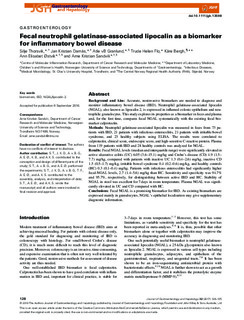| dc.contributor.author | Thorsvik, Silje | |
| dc.contributor.author | Damås, Jan Kristian | |
| dc.contributor.author | Granlund, Atle van Beelen | |
| dc.contributor.author | Flo, Trude Helen | |
| dc.contributor.author | Bergh, Kåre | |
| dc.contributor.author | Østvik, Ann Elisabet | |
| dc.contributor.author | Sandvik, Arne Kristian | |
| dc.date.accessioned | 2017-11-01T08:22:27Z | |
| dc.date.available | 2017-11-01T08:22:27Z | |
| dc.date.created | 2016-09-30T14:53:07Z | |
| dc.date.issued | 2017 | |
| dc.identifier.citation | Journal of Gastroenterology and Hepatology. 2017, 32 (1), 128-135. | nb_NO |
| dc.identifier.issn | 0815-9319 | |
| dc.identifier.uri | http://hdl.handle.net/11250/2463331 | |
| dc.description.abstract | Background and Aim
Accurate, noninvasive biomarkers are needed to diagnose and monitor inflammatory bowel disease (IBD). Neutrophil gelatinase-associated lipocalin (NGAL), also known as lipocalin 2, is expressed in inflamed colonic epithelium and neutrophilic granulocytes. This study explores its properties as a biomarker in feces and plasma and, for the first time, compares fecal NGAL systematically with the existing fecal biomarker calprotectin.
Methods
Neutrophil gelatinase-associated lipocalin was measured in feces from 73 patients with IBD, 21 patients with infectious enterocolitis, 21 patients with irritable bowel syndrome, and 23 healthy subjects using ELISA. The results were correlated to calprotectin, clinical score, endoscopic score, and high-sensitive C-reactive protein. Plasma from 119 patients with IBD and 28 healthy controls was analyzed for NGAL.
Results
Fecal NGAL levels (median and interquartile range) were significantly elevated in active ulcerative colitis (UC) 6.05 (3.6–15.1) mg/kg and Crohn's disease (CD) 4.9 (1.5–7.7) mg/kg, compared with patients with inactive UC 1.3 (0.4–2.6) mg/kg, inactive CD 1.5 (0.5–1.7) mg/kg, irritable bowel syndrome 0.4 (0.2–0.6) mg/kg, and healthy controls (HC) 0.3 (0.1–0.4) mg/kg. Patients with infectious enterocolitis had significantly higher fecal-NGAL levels, 2.7 (1.4–5.6) mg/kg than HC. Sensitivity and specificity was 94.7% and 95.7%, respectively, for distinguishing between active IBD and HC. Stability of NGAL in stool was excellent for 7 days in room temperature. Plasma NGAL was significantly elevated in UC and CD compared with HC.
Conclusions
Fecal NGAL is a promising biomarker for IBD. As existing biomarkers are expressed mainly in granulocytes, NGAL's epithelial localization may give supplementary diagnostic information. | nb_NO |
| dc.language.iso | eng | nb_NO |
| dc.publisher | Wiley | nb_NO |
| dc.rights | Attribution-NonCommercial-NoDerivatives 4.0 Internasjonal | * |
| dc.rights.uri | http://creativecommons.org/licenses/by-nc-nd/4.0/deed.no | * |
| dc.title | Fecal neutrophil gelatinase-associated lipocalin as a biomarker for inflammatory bowel disease | nb_NO |
| dc.type | Journal article | nb_NO |
| dc.type | Peer reviewed | nb_NO |
| dc.description.version | publishedVersion | nb_NO |
| dc.source.pagenumber | 128-135 | nb_NO |
| dc.source.volume | 32 | nb_NO |
| dc.source.journal | Journal of Gastroenterology and Hepatology | nb_NO |
| dc.source.issue | 1 | nb_NO |
| dc.identifier.doi | 10.1111/jgh.13598 | |
| dc.identifier.cristin | 1388328 | |
| dc.relation.project | Norges forskningsråd: 223255 | nb_NO |
| dc.description.localcode | © 2016 The Authors Journal of Gastroenterology and Hepatology published by Journal of Gastroenterology and Hepatology Foundation and John Wiley & Sons Australia, Ltd This is an open access article under the terms of the Creative Commons Attribution-NonCommercial-NoDerivs License, which permits use and distribution in any medium, provided the original work is properly cited, the use is non-commercial and no modifications or adaptations are made. | nb_NO |
| cristin.unitcode | 194,65,15,0 | |
| cristin.unitname | Institutt for klinisk og molekylær medisin | |
| cristin.ispublished | true | |
| cristin.fulltext | original | |
| cristin.qualitycode | 1 | |

